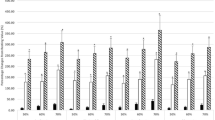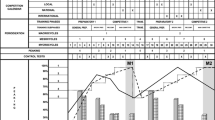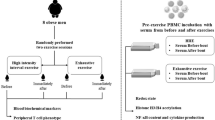Summary
Seventeen healthy cyclists [age 20.8 (SD 4.8) years; body mass 68.3 (SD 7.7) kg; body fat, 11.4 (SD 2.6) %; height, 179.1 (SD 5.9) cm;\(\dot VO_{2max} \) 60.9 (SD 7.4) ml · kg−1 · min−1] conducted intensive endurance exercise to exhaustion (stress test, ST) on a cycle ergometer at 110% of their individual anaerobic threshold [Than,individua; exercise intensity, 3.97 (SD 0.6) W · kg−1 ; duration, 23.9 (SD 8.3) min; maximal lactate concentration, 7.39 (SD 2.59) mmol · 1−1]. The distribution of leucocyte subpopulations was measured flow cytometrically: before, immediately after (0), 5 (+5), 30 (+30) and 60 (+60) min after ST. The lymphocytes (0 min) and granulocytes (+60 min) were mainly responsible for the increase of leucocytes. Lymphocytes were significantly lower at +30 and + 60 min than before. CD3−CD16/CD56+ (+480%) and CD8+-lymphocytes (+211%) increased at 0 min more than the other lymphocyte subpopulations (CD3+-cells, +100%; CD4+ cells, +56%; CD19+-cells, +64%). CD3−CD16/CD56+-and CD8+-cells also were mainly responsible for the decreased values of lymphocytes at +30 min and +60 min compared to before. At 0 min naive CD8+ cells (CD45RA+, CD45RO−) increased more than memory CD8+-cells (CD45RA−, CD45RO+). Changes of naive and memory CD4+-cells did not differ. All lymphocyte subpopulations, in particular CD8+- and CD3−CD16/CD56+-cells, decreased rapidly between 0 min and 5 min. We conclude that an intensive endurance exercise to exhaustion causes a mobilisation of lymphocytes, especially of natural killer cells (CD3−CD16/CD56+) and naive, unprimed CD8+ cells (CD45RA+, CD45RO−) which may be transported to injured muscles. The decreased cell numbers of the latter subpopulations are possibly one reason for the susceptibility to infections during the first hours after exercise. Furthermore, an exact definition of the intensity of exercise and times of taking blood is essential for comparing results describing cell parameters during or after exercise.
Similar content being viewed by others
References
Abo T, Kawate T, Itoh K, Kumagai K (1981) Studies on the bioperiodicity of the immune response. J Immunol 126:1360–1363
Berk LS, Niemann DC, Youngberg WS, Arabatzis K, Simpson-Westerberg M, Lee JW, Tan SA, Eby WC (1990) The effect of long endurance running on natural killer cells in marathoners. Med Sci Sports Exerc 22:207–212
Beverley PCL, Merkenschlager M, Wallace DL (1989) Identification of human naive and memory T cells. In: Melchers F, Adalbert ED, Boehmer H von, Dierich MP, Du Pasquier L, Eichmann K, Gemsa D, Götze O, Kalden JR, Kaufmann SHE, Kirchner H, Resch K, Riethmüller G, Schimpl A, Sorg C, Steinmetz M, Wagner H, Zachau HG (eds) Progress in immunology VII. Springer, Berlin Heidelberg New York, pp 432–438
Borg GAV (1973) Perceived exertion: a note on “history” and methods. Med Sci Sports Exerc 5:90–93
Bunt JC (1986) Hormonal alterations due to exercise. Sports Med 3:331–345
Deuster PA, Curiale AM, Cowan ML, Finkelman FD (1988) Exercise-induced changes in populations of peripheral blood mononuclear cells. Med Sci Sports Exerc 20:276–280
Dill DB, Costill DL (1974) Calculation of percentage changes of blood, plasma, and red cells in dehydration. J Appl Physiol 37:247–248
Ferry A, Picard F, Duvallet A, Weill B, Rien M (1990) Changes in blood leucocyte populations induced by acute maximal and chronic submaximal exercise. Eur J Appl Physiol 59:435–442
Hoffmann-Goetz L, Simpson JR, Cipp N, Arumugam Y, Houston ME (1990) Lymphocyte subset responses to repeated submaximal exercise in men. J Appl Physiol 68:1069–1074
Hohorst HJ (1962) L-(+)-Lactat, Bestimmung mit Lactatdehydrogenase und DPN. In: Bergmeyer HU (ed) Methoden der enzymatischen Analyse. Verlag Chemie, Weinheim
Keast D, Cameron K, Morton AR (1988) Exercise and immune response. Sports Med 5:248–267
Kendall A, Hoffmann-Goetz L, Houston ME, MacNeil B, Arumugam Y (1990) Exercise and blood lymphocyte subset responses: intensity, duration, and subject fitness effects. J Appl Physiol 69:251–260
Krensky AM, Lanier LL, Engleman EG (1985) Lymphocyte subsets and surface molecules in man. Clin Immunol Rev 4:95–138
Landay AL, Muirhead KA (1989) Procedural guide lines for performing immunophenotyping by flow cytometry. Clin Immunol Immunopathol 52:48–60
Lanier LL, Le AM, Civin CI, Loken MR, Phillips JH (1986) The relationship of CD16 (Leu-11) and Leu-19 (NKH-1) antigen expression on human peripheral blood NK cells and cytotoxic T lymphocytes. J Immunol 136:4480–4486
Mackinnon LT (1989) Exercise and natural killer cells. What is the relationship? Sports Med 7:141–149
McCarthy DA, Dale MM (1988) The leucocytosis of exercise. Sports Med 6:333–363
Niemann DC, Berk LS, Simpson-Westerberg M, Arabatzis K, Youngberg WS, Tan SA, Lee JW, Eby WC (1989) Effects of long-endurance running on immune system parameters and lymphocyte function in experienced marathoners. Int J Sports Med 10:317–323
Pabst R (1988) The spleen in lymphocyte migration. Immunol Today 9:43–45
Pedersen BK, Tvede N, Klarlund K, Christensen LD, Hansen FR, Galbo H, Kharazmi A, Halkjer-Kristensen J (1990) Indomethacin in vitro and in vivo abolishes post exercise suppression of natural killer cell activity in peripheral blood. Int J Sports Med 11:127–131
Pizalis C, Kingsley G, Murphy J, Panayi G (1987) Abnormal distribution of the helper-inducer and suppressor-inducer T-lymphocyte subsets in the rheumatoid joint. Clin Immunol Immunopathol 45:252–258
Renzi P, Ginns LC (1987) Analysis of T cell subsets in normal adults — comparison of whole blood analysis technique to Ficoll-Hypaque separation by flow cytometry. J Immunol Methods 98:53–56
Schick P, Trepel F, Eder M, Matzner M, Benedak S, Theml H, Kaboth W, Begemann H, Fliedner TM (1975) Autotransfusion of3H-Cytidine-labelled blood lymphocytes in patients with Hodgkin's disease and non-Hodgkin patients. Acta Haemat 53:206–218
Stauber WT, Fritz VK, Vogelbach DW, Dahlmann B (1988) Characterization of muscle injured by forced lengthening. I. Cellular infiltrates. Med Sci Sports Exerc 20:345–353
Stegmann H, Kindermann W, Schnabel H (1981) Lactate kinetics and individual anaerobic threshold. Int J Sports Med 2:160–165
Trepel F (1974) Number and distribution of lymphocytes in man. A critical analysis. Klin Wochenschr 52:511–515
Westermann J, Pabst R (1990) Lymphocyte subsets in the blood: a diagnostic window on the lymphoid system? Immunol Today 11:406–410
Author information
Authors and Affiliations
Rights and permissions
About this article
Cite this article
Gabriel, H., Urhausen, A. & Kindermann, W. Circulating leucocyte and lymphocyte subpopulations before and after intensive endurance exercise to exhaustion. Europ. J. Appl. Physiol. 63, 449–457 (1991). https://doi.org/10.1007/BF00868077
Accepted:
Issue Date:
DOI: https://doi.org/10.1007/BF00868077




